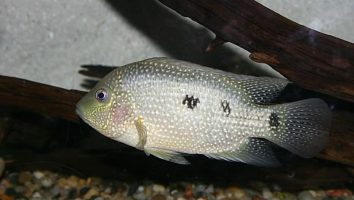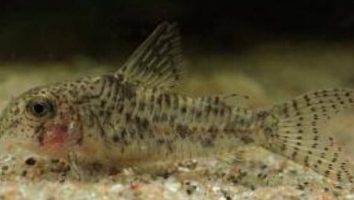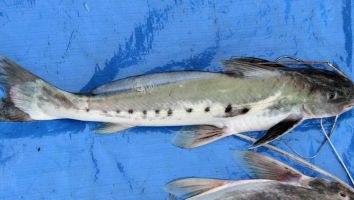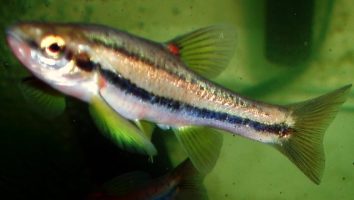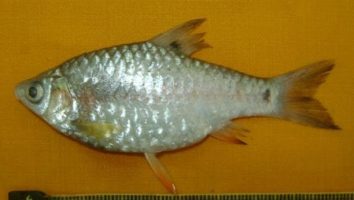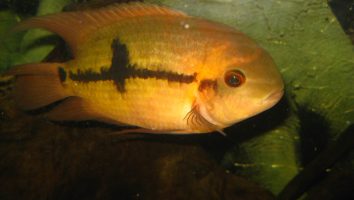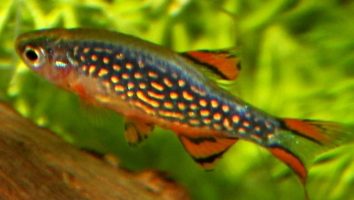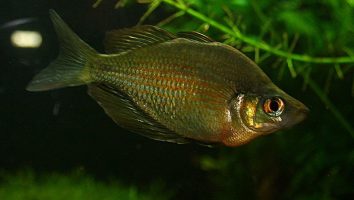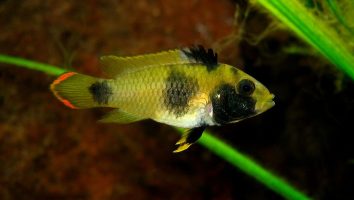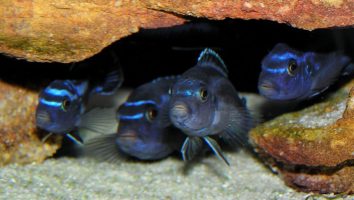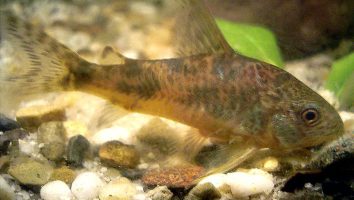The chocolate cichlid is a stunning freshwater fish that is perfect for beginner aquarists. They are easy to care for and can be kept in a wide range of tank sizes.
This guide will teach you everything you need to know about chocolate cichlid care. You’ll learn about their diet, size, lifespan, and more!
Table of contents
Species overview
Chocolate cichlids (scientific name: Amphilophus trimaculatus) are found in the wild in various parts of Central America, including Costa Rica, Nicaragua, and Panama.
They prefer slow-moving waters with a lot of vegetation, and they are often found in small creeks and rivers.
Chocolate cichlids are omnivorous, which means they will eat both plants and animals. In the wild, their diet consists mostly of insects, crustaceans, and small fish.
These fish are very popular in the aquarium trade because of their unique coloration. Chocolate cichlids are brown with three dark vertical stripes running down their bodies.
Appearance
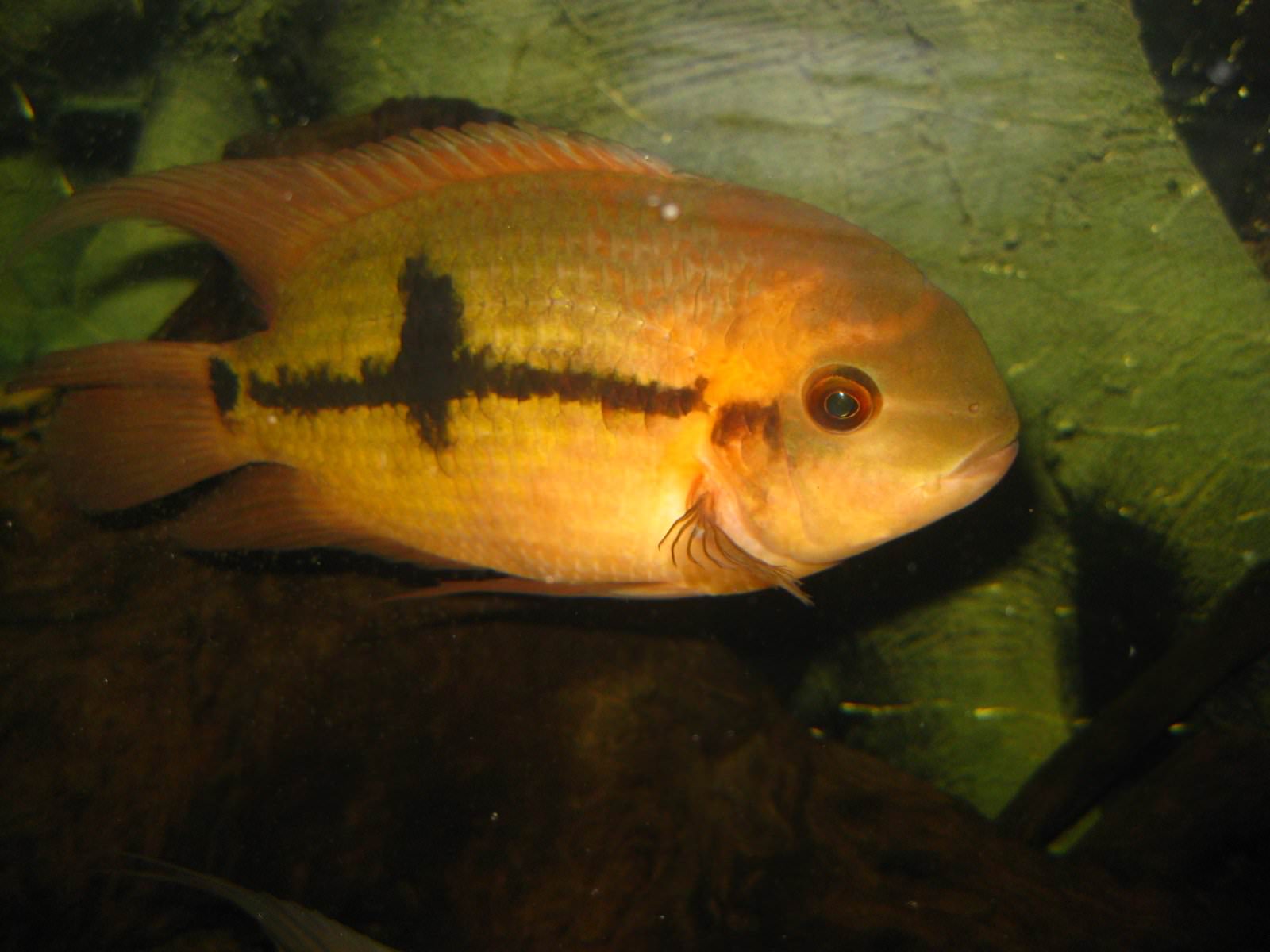
The chocolate cichlid is a beautiful fish that is dark brown in coloration. The body of the chocolate cichlid is elongated and oval shaped. The chocolate cichlid has a protruding lower jaw and large eyes. The dorsal fin of the chocolate cichlid is tall and triangular in shape. The chocolate cichlid also has a large and round caudal fin. The chocolate cichlid can grow to be about 6-8 inches in length.
The chocolate cichlid is a peaceful fish that is good for community tanks. The chocolate cichlid is not an aggressive fish but may become territorial with other chocolate cichlids. The chocolate cichlid should be kept with other peaceful fish. The chocolate cichlid is a good beginner fish for people new to keeping cichlids.
Lifespan
The chocolate cichlid has a lifespan of anywhere from 5 to 10 years. The main factor impacting their lifespan is the level of care they receive. If they’re kept in subpar conditions, their lifespan will be on the lower end of this range.
But if they’re well cared for, they can easily live for 10 years or more. These are very hardy fish, so as long as you meet their basic needs they’ll do just fine.
Size
Chocolate cichlids can grow to be around 8 inches in length, with males typically being larger than females.
Tank
Tank Size
The minimum tank size for a chocolate cichlid is 30 gallons.
If you want to keep more than one chocolate cichlid in the same tank, you’ll need to add at least another 30 gallons for each fish.
Chocolate cichlids are also known to be rather active swimmers so you may want to consider a larger tank if you have the space for it.
Water Parameters
The chocolate cichlid is a freshwater fish that is native to Central America. In the wild, they are found in slow-moving rivers and streams with a sandy bottom.
They are a relatively peaceful fish but can be aggressive towards other chocolate cichlids. In the wild, they are known to eat mostly insects and small crustaceans.
In captivity, they should be fed a diet that consists of high-quality cichlid pellets, as well as live and frozen foods.
When it comes to water parameters, the chocolate cichlid is very adaptable. However, they prefer water that is on the softer side with a pH level of 7.0-8.0. The water temperature should be kept between 74-82 degrees Fahrenheit.
What To Put In Their Tank
As with most cichlids, Chocolate cichlids are fairly adaptable when it comes to the décor in their tank.
That being said, there are still a few things you’ll want to consider to create the best environment possible.
The first is the substrate. These fish like to dig, so you’ll want to use something soft like sand. This will help prevent any cuts or scrapes that could be caused by a rougher substrate.
Chocolate cichlids also prefer a tank with plenty of hiding spots. This can be in the form of caves, plants, or driftwood.
As we mentioned, plants can be a little tricky with these fish since they like to dig. If you do want to include them, choose something that’s hardy and can withstand a little abuse.
You’ll also want to make sure there’s plenty of open space for these fish to swim. They’re not the biggest cichlids out there, but they still need room to move around.
Common Diseases
Chocolate cichlids, like all other fish, can fall ill from time to time. The most common diseases that these fish experience are the usual freshwater culprits.
Ich is the most common, but various other infections and parasites can strike too. Be on the lookout for anything out of the ordinary so you can act fast.
White spots, scars, cuts, or a change in behavior are all causes for concern. Even a disease that isn’t very severe can progress into something serious if left untreated.
When you notice something it’s important to act fast. Consult your vet and begin treatment immediately. The sooner you act, the higher the chance is that your fish will recover.
Of course, the best way to keep the risk of disease low is by simply keeping the tank in great shape. Not providing clean, high-quality water conditions will significantly increase the chance of your chocolate cichlid getting sick.
Behavior & Temperament
The chocolate cichlid is a beautiful fish that’s known for being relatively peaceful. These fish are perfect for beginner aquarists because they’re easy to care for and don’t need a lot of attention.
Although they are peaceful, they are still cichlids. That means they can be territorial at times. They are more likely to become aggressive when they are spawning or if they feel like their territory is being threatened.
When they’re not spawning, they tend to be relatively laid back. They’ll spend most of their time hanging out at the bottom of the tank, sifting through the substrate for food.
They are also known to be good parents. If you’re looking to breed chocolate cichlids, you’ll be happy to know that they take very good care of their young.
Tank Mates
Chocolate cichlids are not the most compatible fish in the world. In the wild, they’re known to be quite aggressive.
This aggression carries over into the aquarium, and they’re not afraid to show it. They’re also large fish that need plenty of space to swim.
For these reasons, it’s best to choose tank mates that are similarly sized and can hold their own.
Some chocolate cichlid tank mates include:
- Green Terror Cichlid
- Jack Dempsey Cichlid
- Firemouth Cichlid
- Convict Cichlid
- Oscar Cichlid
- Piranha
Breeding
Chocolate cichlids are maternal mouthbrooders. The female will lay her eggs in a cave or other hiding spot, then pick them up in her mouth. After that, the fry will stay in her mouth for protection until they’re free-swimming and can take care of themselves.
To get started, set up a breeding tank that’s at least 30 gallons. The water should be between 78 and 82 degrees Fahrenheit. Then, add some hiding spots and caves. These fish like to lay their eggs in dark, hidden places.
When ready, add one male and two females to the tank. The female will lay around 200 eggs. After she lays them, the male will fertilize them.
Once the eggs are fertilized, the female will pick them up in her mouth and keep them there for protection. The fry will stay in her mouth for around three weeks.
During that time, you won’t need to feed the fry. The female will provide them with everything they need.
After three weeks, the fry will be free-swimming and ready to be on their own. At that point, you can start feeding them baby brine shrimp and other small foods.
Conclusion
The chocolate cichlid is a great fish for anyone who wants to add a little bit of personality to their tank.
These fish are relatively easy to care for and get along well with other community fish. They’re also very affordable, which is always a bonus.
The only downside to these fish is that they can be a bit aggressive, so you’ll need to be mindful of that if you decide to add one to your tank.
Overall, we think the chocolate cichlid is a great option for anyone who’s looking for a new fish to add to their tank!

